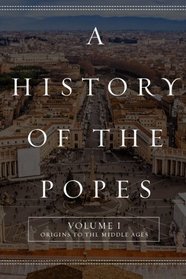This first (of three) volume(s) starts with Peter and moves over 900 years to the pontificate of Leo V. The author starts by explaining that the papacy did not operate in any way near the way it does now. Some of the early popes' biographical info is sketchy because of the lack of records. I liked that the author ties the biographical info to the records that are available. It is interesting to see that the popes weren't necessarily Italian aristocrats. The early popes had a variety of backgrounds; there was a former slave, a hermit, as well as popes from Africa (St. Victor I, to name one), Germany, and a couple of Syrians.
Because Christianity was spreading so far and wide, there came to be different interpretations of God's word. By the time of St. Pius I (died 155 CE), he was more assertive in religious disputes. Differing social customs between the East Church and West Church started to arise. It is amazing that by 217 CE, there was already an antipope (someone who attempts to take the place of the lawful pope). Antipopes were amazingly frequent in the early days.
As early as 514 CE, St. Hormisdas became pope. He had been married before ordination and his son, Silverius, would later become a pope (Silverius was also one of the few popes to resign {accused of conspiring with the Goths}). Another common occurrence was a Synod or a Council, called to hammer out some religious controversy or to determine a policy that the church would follow. One example is the Council of Chalcedon, which declared that Christ has two natures: human and divine.
Throughout this volume, it is staggering to see how many heretical policies have to be squashed by the Catholic Church. In 533 CE, began the policy of changing the pontiff's name at the time of his election. This is because John II was elected and his name was Mercury, the name of a pagan god. In 768 CE, a synod decided that only deacons and cardinal-priests could become pope (there had been lay people elected to the pope prior to this time). In 882, Pope John VIII was the first pope to be assassinated. Two popes later, St. Adrian III was also assassinated.
I'd recently experienced 36 lectures on the papacy (2000 Years of Papal History: The History of the Popes, the Papacy, and the Catholic Church -- Dr.John O'Malley {Great Courses Series}) but I found much to enjoy and learn from this book. It was surprising to learn how many men elected to pope did not want the position.
Because Christianity was spreading so far and wide, there came to be different interpretations of God's word. By the time of St. Pius I (died 155 CE), he was more assertive in religious disputes. Differing social customs between the East Church and West Church started to arise. It is amazing that by 217 CE, there was already an antipope (someone who attempts to take the place of the lawful pope). Antipopes were amazingly frequent in the early days.
As early as 514 CE, St. Hormisdas became pope. He had been married before ordination and his son, Silverius, would later become a pope (Silverius was also one of the few popes to resign {accused of conspiring with the Goths}). Another common occurrence was a Synod or a Council, called to hammer out some religious controversy or to determine a policy that the church would follow. One example is the Council of Chalcedon, which declared that Christ has two natures: human and divine.
Throughout this volume, it is staggering to see how many heretical policies have to be squashed by the Catholic Church. In 533 CE, began the policy of changing the pontiff's name at the time of his election. This is because John II was elected and his name was Mercury, the name of a pagan god. In 768 CE, a synod decided that only deacons and cardinal-priests could become pope (there had been lay people elected to the pope prior to this time). In 882, Pope John VIII was the first pope to be assassinated. Two popes later, St. Adrian III was also assassinated.
I'd recently experienced 36 lectures on the papacy (2000 Years of Papal History: The History of the Popes, the Papacy, and the Catholic Church -- Dr.John O'Malley {Great Courses Series}) but I found much to enjoy and learn from this book. It was surprising to learn how many men elected to pope did not want the position.




